What Is a Concrete Mixer | Types of Concrete Mixer | Specifications of the Concrete Mixer | How to Mix Concrete in a Mixer

Table of Contents
Introduction of Concrete Mixer
Concrete is one of the main and widely used building materials in construction. Concrete is prepared by mixing cement, aggregates, and water.
Traditionally concrete is prepared by manually mixing cement, aggregates, and water with the help of construction tools. But the concrete which is made by manual mixing does not give desired strength because it is impossible to mix complete concrete properly.
During the construction of megastructures, the concrete is required in the bulk quantity and it is not possible to prepare concrete in bulk quantity by manual mixing.
Manual mixing of the concrete consumes a lot of time and does not give the desired strength to the concrete. That’s why nowadays concrete mixers are used for preparing concrete on site.
There are various types of concrete mixers are available in the market as per the requirement and conditions of the construction site.
In this article, we will discuss the What is Concrete Mixer and the Types of Concrete Mixer which are used in the manufacturing of concrete on site.
What Is a Concrete Mixer?

Concrete mixer is a mechanical machine which is used for the manufacturing of concrete by homogeneously mixing cement, aggregates, and water in the appropriate proportion.
Concrete Mixer mix all ingredients of concrete properly. For mixing of the various ingredients of the concrete, the manufacturer used the various types of concrete mixers. The selection of the particular type of concrete mixer depends upon the quantity of concrete required and cost of the project.
Specifications of the Concrete Mixer
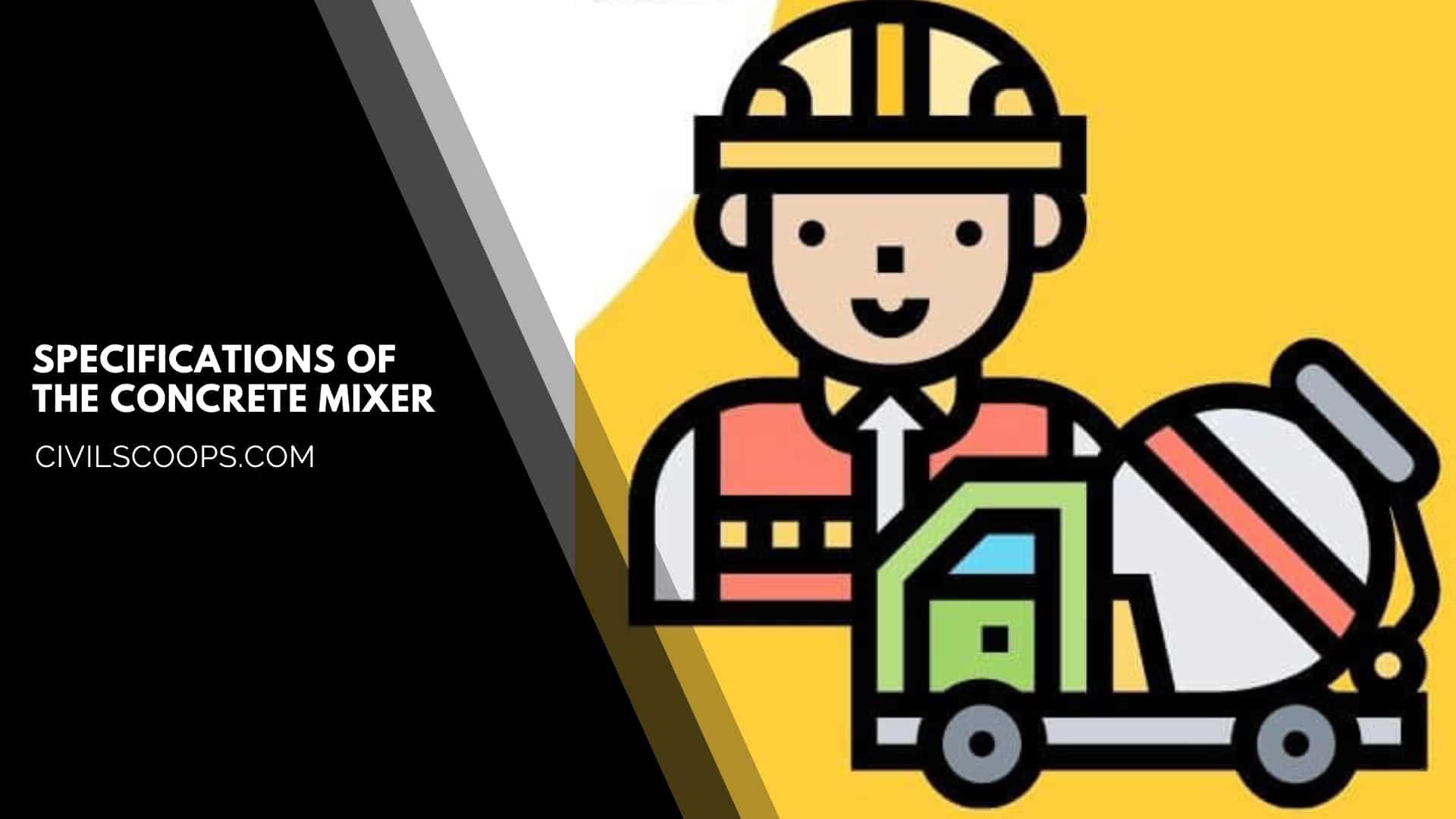
The specifications of the concrete mixers are as follows.
- The mix drum capacity of the concrete mixer are 1200 liter,560 liters, 480 liters, 200 liter,s etc.
- The production capacity of the concrete mixer is about 5 cubics/hr.
- Drum Speed of the concrete mixer is 20-22 rpm.
- The weight of the concrete mixer machine is about 130 kg.
Also Read: How Cement is Made | Cement Ingredients | History of Cement
Types of Concrete Mixer
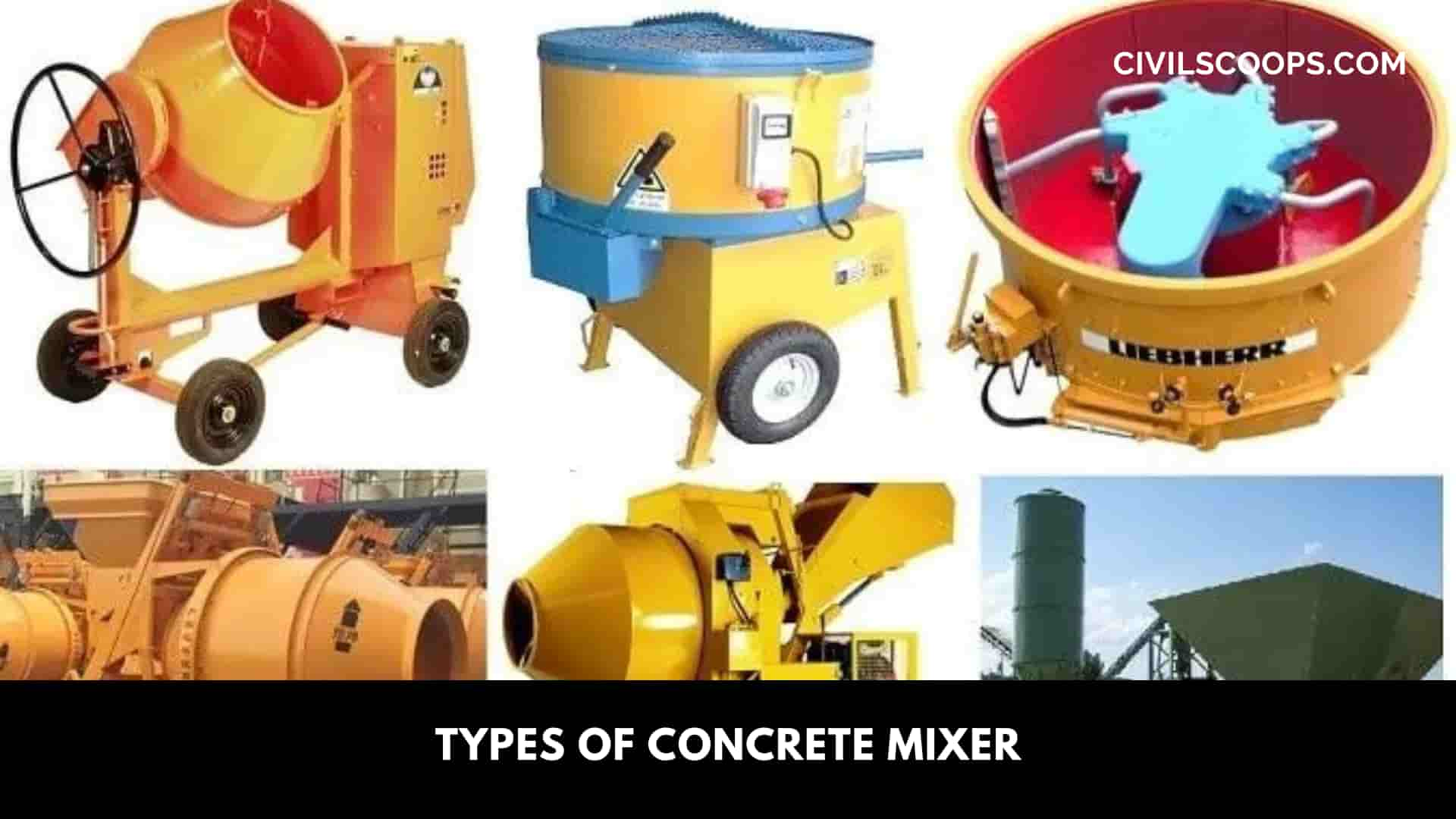
They are two different types of concrete mixer as follows.
- Batch Mixers or Drum Mixer
- Tilting Concrete Mixer
- Non-Tilting Concrete Mixer
- Reversing Drum Concrete Mixer
- Pan Type Concrete Mixer
- Continuous Mixer
1. Batch Concrete Mixer
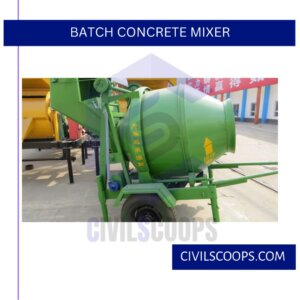
Batch mixer is one of the common and widely used concrete mixing machines. In the case of the batch concrete mixers, the concrete mix is collected batch by batch and time by time. In this types of concrete mixers, we have to add cement, aggregate, water, and after some time of mixing it will discharge the concrete.
Batch mixer consists of a revolving drum with blades fitted inside it. All the ingredients of the concrete in the appropriate preposition are added into the Hopper of the revolving drum.
The Revolving drum revolves at a certain speed and mixes all the ingredients of the concrete with the help of blades fitted inside the Hopper of the concrete mixer.
In the case of a batch concrete mixer, it is necessary to control and monitor the speed of the revolving drum and the angle of inclination of the rotation axis to manufacture the quality concrete.
1.1. Tilting Mixer
The Tilting mixer has a conical-shaped drum that has vanes inside it. The tilting type mixtures are generally used for mixing the concrete of low workability. Tilting concrete mixers are used for mixing large size aggregates.
In the case of the tilting mixers, the mixing drum can be tilted for discharging the concrete. Aggregates whose sizes are greater than 7.5 cm are also effectively mixed in this type of concrete mixer.
Advantages of Tilting Concrete Mixer
The advantages of Tilting concrete mixers are as follows.
- The greater size aggregates can be effectively mixed in the tilting concrete mixers.
- Tilting concrete mixer is used for mixing of the concrete of low workability.
- Tilting mixers are easy to install and suitable for large-scale projects.
Disadvantages of Tilting Concrete Mixer
There are also some disadvantages of Tilting concrete mixers which are as follows.
- These concrete mixers are not suitable for manufacturing high-workability concrete.
1.2. Non- tilting Concrete Mixer
The non-tilting type of concrete mixer is not allowed to tilt and the axis of this type of concrete mixer is always horizontal. The discharge of this type of concrete mixture is done by reversing the direction of the rotation of the drum.
Advantages of Non-Tilting Concrete Mixer
The advantages of Non-Tilting concrete mixers are as follows.
- Non-tilting type of mixtures has openings on both sides.
- Non-tilting types of concrete mixers are suitable for small-scale construction sites.
Disadvantages of Non-Tilting Concrete Mixer
There are also some disadvantages of Non-Tilting concrete mixers which are as follows.
- The non-tilting type of concrete mixtures is not suitable for large size aggregates.
- It is very difficult to clean the non-tilting concrete mixer.
1.3. Reversing Drum Concrete Mixer
Reversing drum mixers have reversing arrangement which is known as the Reversing Drum concrete mixer. In the case of the reversing drum concrete mixer, the ingredients of the concrete will rotate only in one direction and discharge from the opposite direction.
The Reversing drum concrete mixers are the same as the non-tilting type of concrete mixers. In the reversing drum concrete mixers, the different sets of blades are arranged for the mixing of the concrete. This type of concrete mixer is suitable for mixing dry concrete.
Advantages of Reversing Drum Concrete Mixer
The advantages of Reversing drum concrete mixer are as follows.
- Reversing drum concrete mixers are used for mixing dry concrete.
- It consists of blades that help in the proper mixing of the concrete.
Disadvantages of Reversing Drum Concrete Mixer
There are also some disadvantages of Reversing drum concrete mixer which are as follows.
- In the reverse drum concrete mixer, the drum will rotates only in one direction.
- The discharge of the concrete in this type of mixer is in the opposite direction.
1.4. Pan Type Concrete Mixer
The Pan-type concrete mixer consists of a cylindrical fan that has a set of blades that helps to mix the various concrete ingredients. The pan-type concrete mixers generally discharge concrete from the bottom of the pan.
Advantages of Pan Type Concrete Mixer
The advantages of Pan type concrete mixers are as follows.
- The pan-type concrete mixer has a large cylindrical pan in which a large amount of concrete can be mixed.
- The concrete can be discharged from the bottom of the pan in the case of pan type concrete mixer.
Disadvantages of Pan Type Concrete Mixer
The disadvantages of Pan type concrete mixers are as follows.
- Pan-type concrete mixers are expensive as compared to other types of concrete mixers.
2. Continuous Concrete Mixer
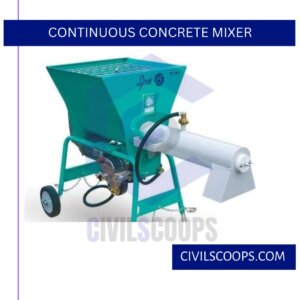
Continuous concrete mixer is used in large-scale construction projects such as dams, bridges, etc. The massive construction projects required a large quantity of concrete in the continuous flow.
In the case of the continuous concrete mixers the weighing, loading, and mixing of the concrete as well as discharge of the concrete is done in a continuous manner.
Advantages of Continuous Concrete Mixer
The advantages of Continuous Concrete mixers are as follows.
- The continuous concrete mixers can produce concrete without any interpretation.
- It can produce concrete in large quantities.
Disadvantages of Continuous Concrete Mixer
The disadvantages of continuous concrete mixers are as follows.
- The continuous concrete mixers are only suitable for large-scale construction projects.
- Continuous concrete mixers required large space for their installation.
Also Read: 19 Different Types of Slabs in Construction | What Is a Slab | Types of Slabs
How to Mix Concrete in a Mixer?
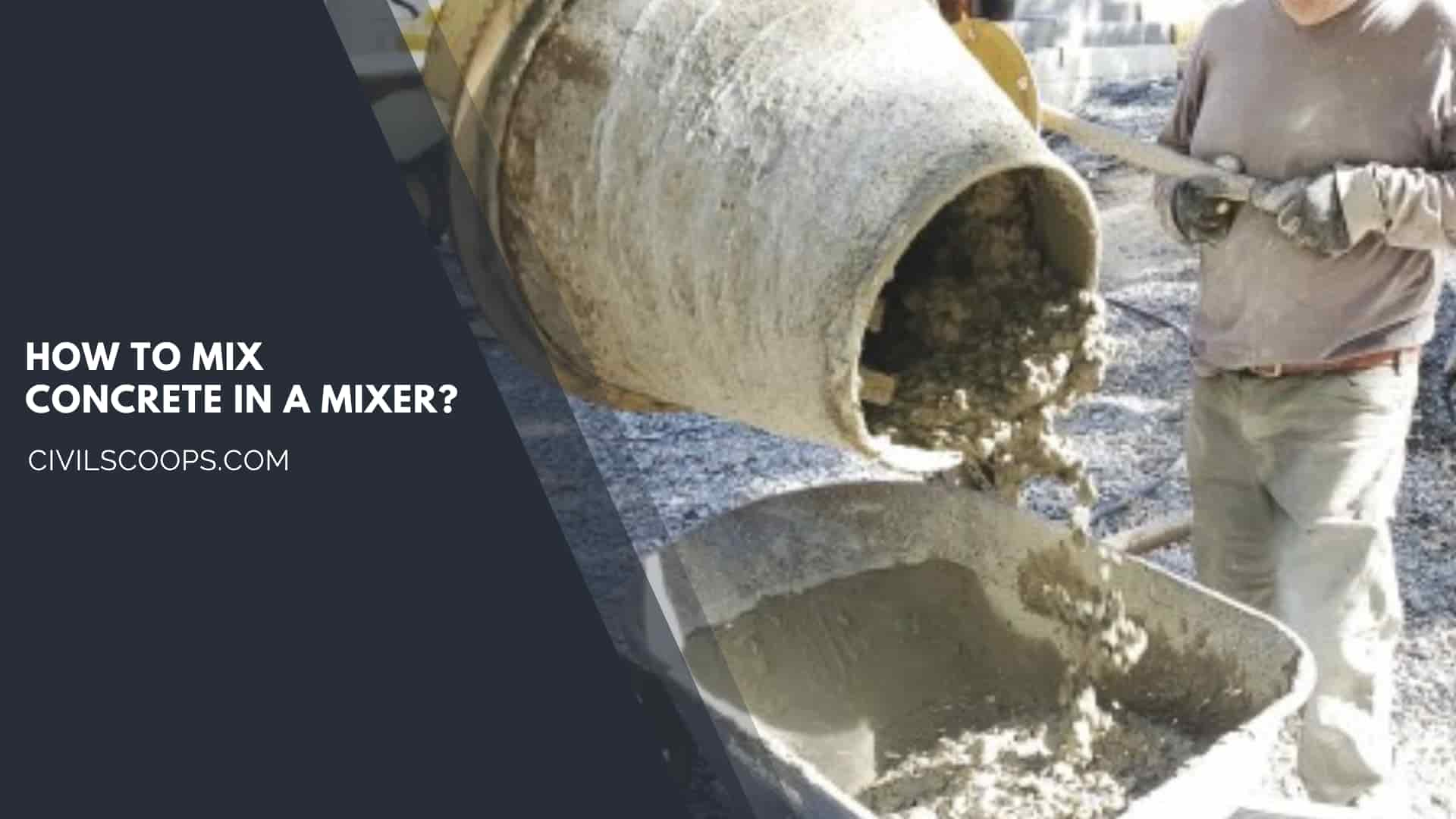
The step-by-step procedure of concrete mixing in a mixer are as follows.
- First upon calculate the quantity of water required for the total mixture.
- Add half of the total mixture into the mixer before adding dry mix.
- Turn on the mixer and add the dry mix into it. Allah the concrete mixer revolves for a minute and then add remaining water in it.
- Mix the mixture for about 3 to 5 minutes until a uniform and required workable concrete is prepared.
- If the concrete made is of lower workability then add some water to it.
- After getting the desired concrete, discharge it and can be used in the construction.
[su_box title=”FAQ” style=”default” box_color=”#333333″ title_color=”#FFFFFF” radius=”3″ class=”” id=””]
Types of Concrete Mixer
- Batch mixers. Drum Types Mixer. Tilting drum mixers. Non-tilting drum mixer. Reversing drum mixer. Pan Type Mixer.
- Continuous mixers.
How Much Concrete Can You Mix in a Cement Mixer?
Most standard mixers allow for a maximum of two 80# bags of concrete per batch for a total of 24 bags in an hour. Mixing flat-out, the output of this mixing method is capped at about 14 sq. ft. of material.
How to Make a Concrete Mixer?
- Gather your tools.
- Make the three in-the-drum paddles.
- Apply bondo liberally to the bottom and sides.
- Thread the pieces together to form the frame.
- Mark and drill the cotter pin holes close to the disks.
- Grease the axle and secure the assembly with 2 cotter pins.
How Much Does a Concrete Mixer Weigh?
Is a Cement Mixer Worth It?
A cement mixer is a handy tool that can be used for a wide variety of residential home repair and remodeling projects. And it can mix more than concrete. If you will be doing jobs involving cement, mortar, or similar materials regularly, a cement mixer can save you a lot of time and energy.
How Does a Concrete Mixer Work?
A concrete mixer truck has a revolving drum mounted on the back. This drum mixes the components; a combination of cement (a complex blend of minerals), water and gravel (or stone) together to make concrete. Portable concrete mixers are still used on job sites where a smaller volume of concrete is required.
Is It Worth Buying a Concrete Mixer?
If you’re doing a simple crack repair or pouring concrete in a small area, you don’t need a concrete mixer. You can use a wheelbarrow or bucket to mix your concrete, and you’ll save yourself potentially hundreds of dollars. If your project is much bigger, then consider a concrete mixer.
Do I Need a Concrete Mixer?
The Bottom Line. While you can use a mixer for just about any concrete job you want to tackle, whether you actually need one basically boils down to the project’s size. Smaller projects, like creating a stepping stone path or stylish concrete planters don’t require whipping out the mixer.
What Is Concrete Mixer Machine?
Uses of Concrete Mixer in Construction
Concrete mixers are devices capable of preparing concrete mixtures of varying strength precisely as well as quickly. Some concrete mixers are even capable of dispensing the concrete mixture directly on the location of the construction.
Continuous Concrete Mixer
Continuous mixers are fully-automated machines that continuously mix dry premixed mortar into a workable compound. The main areas of application are masonry mortar and adhesives.
[/su_box]
[su_note note_color=”#F2F2F2 ” text_color=”#333333″ radius=”3″ class=”” id=””]
Like this post? Share it with your friends!
Suggested Read –
- What Is Plaster | Methods of Plastering
- All About Grillage Foundation | Types of Grillage Foundation | Features of Grillage Foundation
- What Is Bracing | Types of Bracing | What Does Brace Mean | Advantages & Disadvantages of Bracing Systems
- What Is Pier Foundation | Types of Drilled Piers | Advantages and Disadvantages of Drilled Pier Foundations
- What Is Caisson Foundation | Types of Caisson Foundation | Advantage, Disadvantage, Application, & Construction of Caisson
[/su_note]
Originally posted 2023-04-06 06:53:19.
